Impact of dietary habit changes on college students physical health insights from a comprehensive study
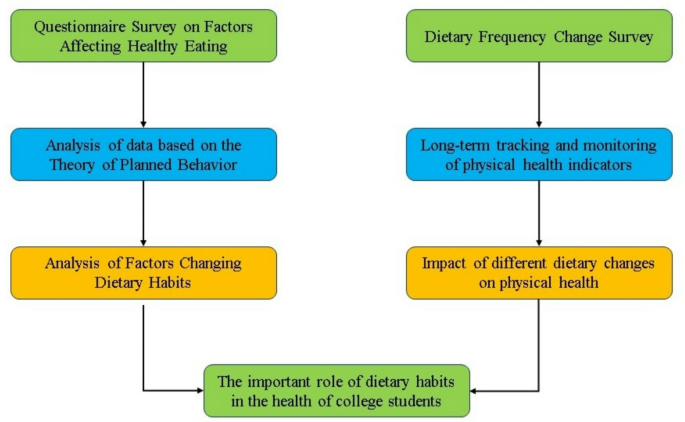
Dietary choice behavior results
Reliability and validity are critical indicators for assessing the quality of a questionnaire. Reliability refers to the consistency and stability of the questionnaire across different contexts, typically evaluated through internal consistency tests. In this study, Cronbach’s α coefficient was employed to assess the internal consistency of the questionnaire26. The results indicated that the α coefficients for all dimensions were above 0.68, signifying high internal consistency. Validity, on the other hand, serves as an essential measure of the questionnaire’s accuracy. Initially, several domain experts were invited to review the various items of the questionnaire, resulting in a content validity index (CVI) of 0.82, which indicates good content validity27. Subsequently, the average variance extracted (AVE) and composite reliability (CR) for each dimension were calculated. The results showed that the CR values for all dimensions were above 0.7, and the AVE values exceeded 0.5, indicating strong convergent and discriminant validity. The findings of the questionnaire reliability test are presented in Table 2. In summary, the reliability and validity of the questionnaire in this study meet the necessary requirements.
Finally, Pearson correlation analysis was used to test the relationship between the questionnaire and the mean values of the factors. As shown in Table 3, the significant correlation of the mean values of the factors is at the 0.01 level of significance, which indicates that all the factors of the questionnaire are significantly related to each other.
Based on the complexity characteristics of the structural equation model, the overall fit of the model is usually judged on the basis of a comprehensive evaluation of multiple fit indices. The cardinal degrees of freedom ratio (χ2/df) should be between 2 and 5. The comparative fit index (CFI) value, goodness of fit index (GFI), adjusted goodness of fit index (AGFI), etc., should be > 0.9, and the closer these values are to 1, the better the structural equation model fit is. The root mean square error of approximation (RMSEA) value is in the range of 0 to 1, and the closer it is to 0, the smaller the structural equation modeling error28. The model fitting indices of this study are shown in Table 4, which are all within the acceptable range, and the fitting indices are basically appropriate.
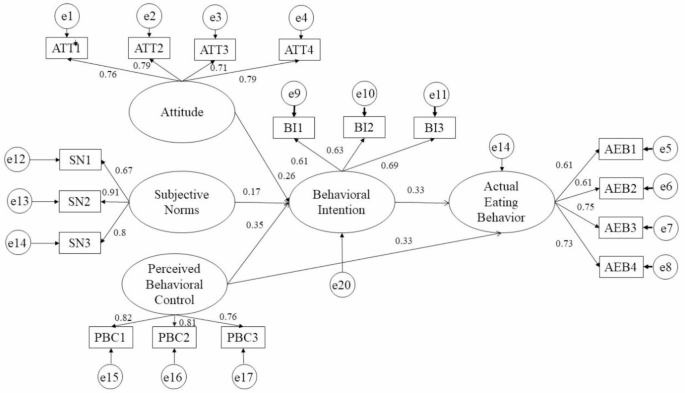
Dietary choice intention model.
To explore the comprehensive effects of various factors on dietary behavior, we combined the results of the final dietary behavior influencing factors model (Fig. 3) and conducted a total effect analysis, as shown in Table 5. The results indicate that perceived behavioral control has the greatest influence on college students’ dietary habit choices. Additionally, dietary behavioral intention is also a significant factor influencing their dietary choices. This suggests that college students can effectively maintain healthy eating habits if they possess both the confidence to make healthy choices and the intention to adhere to these behaviors in their daily diet29.
Dietary change frequency analysis
Through the FTQ, the frequency of dietary changes among college students since entering college was statistically analyzed. As shown in Table 6, it can be observed that students have experienced notable changes in their staple food consumption, particularly in their pasta habits. This is likely due to students from northern provinces, where noodles are a staple food, adapting to the southern region, where rice is more commonly consumed. Among other foods, instant noodles and snacks exhibited the most frequent changes, likely because of their affordability and convenience, making them preferred options when college students face time constraints. Additionally, significant changes were observed in the consumption of mixed grains, potatoes, cruciferous vegetables, and nuts, which may reflect a general shift among students toward healthier eating habits. Lastly, the frequency of consuming fried and preserved foods also changed, possibly due to limited access to such foods in the college’s geographic region.
Results of dietary change
After identifying the main motivations for dietary changes among college students, the next step was to analyze the impact of these changes on their physical health. As outlined in “Dietary change frequency analysis”, Through the above survey, we found that the change in eating habits is concentrated in high-calorie foods, high-fiber foods, and high-oil and high-salt foods. To investigate the effect of these dietary changes, 240 male college students participated in a 6-month follow-up experiment. The students were divided into three groups, each corresponding to one of the three dietary changes:
Group 1: Transition from high-calorie foods to low-calorie foods.
Group 2: Transition from low dietary fiber to high dietary fiber.
Group 3: Transition from high-oil and high-salt foods to low-oil and low-salt foods.
Physical fitness tests, including BMI, blood pressure, lung capacity, and the 6MWT, were conducted before and after the dietary changes to assess their impact on the participants’ physical fitness. The results were compared to determine which dietary change had the greatest influence on the college students’ health.
SBP and DBP
The physical fitness test results after different dietary changes were evaluated. To analyze the impact of these changes on the participants’ BP, a paired samples t-test was conducted on their SBP and DBP before and after the dietary modifications. The results, shown in Table 7, reveal a decreasing trend in BP across all three dietary changes, with a significant correlation between the changes and the decrease in BP (P < 0.001).
As shown in Figs. 4 and 5, the most pronounced reduction in BP occurred in the group that reduced their intake of high-oil and high-salt foods. This group showed a 6.6% reduction in mean SBP and a 6.9% reduction in mean DBP. The group that reduced their intake of high-calorie foods experienced a 5.3% decrease in mean SBP and a 5.1% decrease in mean DBP. The smallest reduction was observed in the group that increased dietary fiber intake, with a 3.9% reduction in mean SBP and a 2.8% reduction in mean DBP.
These results suggest that a high-salt diet is one of the primary contributors to elevated BP. Previous research has demonstrated that reducing salt intake can significantly lower both SBP and DPB30. Additionally, reducing high-oil food intake helps prevent elevated blood lipids and improves vascular health. Thus, reducing the consumption of high-oil and high-salt foods appears to be the most effective approach for controlling BP.
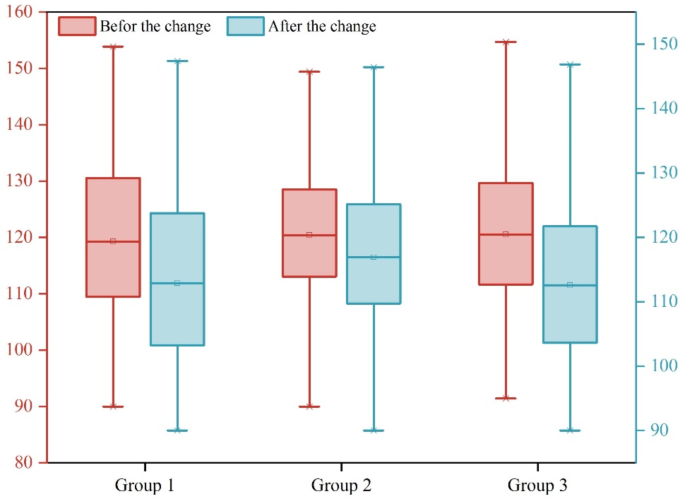
SBP before and after two measurements (in mmHg).
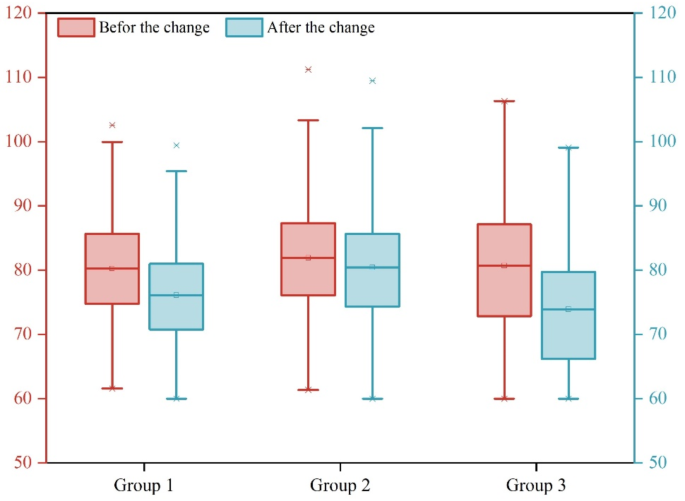
DPB before and after two measurements (in mmHg).
BMI
Figure 6 illustrates the changes in BMI values of the participants after different dietary adjustments, while Table 8 presents the paired samples t-test results for BMI changes. The statistical analysis revealed significant changes in BMI across all three groups (p < 0.001), indicating that dietary modifications had a measurable impact on the BMI of the college students.
Reducing high-calorie food intake led to the most significant reduction in BMI, with a 6.8% decrease. This was followed by a 4.8% decrease in BMI for the group that increased dietary fiber intake, while the group that reduced high-oil and high-salt food intake saw the smallest reduction, at 2.1%.
High-calorie foods, such as sugary drinks, fried items, and desserts, are key contributors to excessive calorie intake and subsequent weight gain. By cutting down on these foods, participants directly reduced their overall calorie consumption, resulting in more effective BMI control31. Increasing dietary fiber intake also played a notable role in BMI reduction, as fiber promotes satiety, reduces overall calorie intake, and supports gut health and metabolism. Research supports the finding that sufficient dietary fiber intake can effectively lower body fat percentage and body weight32.
In contrast, reducing high-oil and high-salt food intake was less impactful on BMI because such foods primarily affect water retention and BP rather than directly influencing calorie intake. This suggests that merely lowering oil and salt intake may not be as effective in controlling BMI unless coupled with efforts to reduce overall caloric intake.
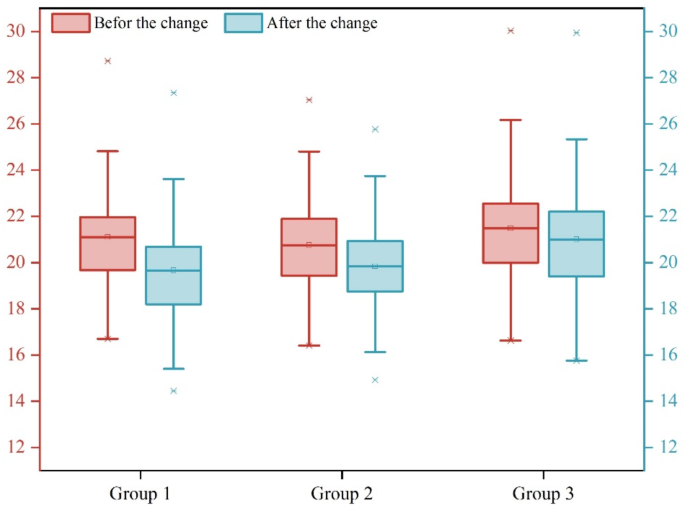
BMI before and after two measurements (in kg/m2).
Lung capacity
The lung capacity test results are illustrated in Fig. 7, and the paired samples t-test analysis results are presented in Table 9. The analysis demonstrated that all three groups, which underwent dietary changes, experienced significant improvements in their lung capacity test results (p < 0.001). This suggests that the dietary modifications had a substantial positive impact on lung function. It is evident that reducing high-calorie food intake (Group 1) led to the largest increase in lung capacity, with a 4.2% improvement in the mean test value. This was followed by the group that increased dietary fiber intake (Group 2), which saw a 3.1% improvement, and lastly, the group that reduced high-oil and high-salt food intake (Group 3), which experienced a 2.5% increase.
The greater improvement in lung capacity from reducing high-calorie foods can be attributed to the prevention of weight gain. Excessive body weight places an additional burden on the respiratory system, limiting lung function. Reducing calorie-dense foods like sugary drinks, desserts, and fried foods directly aids in weight loss, which, in turn, alleviates stress on the chest and respiratory muscles, leading to improved lung capacity. Obesity is often linked with respiratory issues such as asthma and shortness of breath, and weight reduction can mitigate these conditions, resulting in enhanced lung function.
Additionally, increasing dietary fiber not only promotes better digestive health and helps maintain body weight, but it may also support overall respiratory health. Fiber-rich foods often accompany a diet richer in fruits, vegetables, and whole grains, which are high in antioxidants and essential nutrients that can positively influence lung function. Therefore, the improvements seen in lung capacity for Group 2 may be a result of both weight maintenance and the overall nutritional benefits of a higher fiber diet.

Lung capacity before and after two measurements (in ml).
6MWT
The results of the 6MWT are shown in Fig. 8, and the results of the paired-samples t-test are shown in Table 10, which shows that the test results of the three groups of subjects changed significantly after the dietary changes (p < 0.001), which indicates that decreasing the intake of high-calorie foods, increasing the intake of dietary fibers, and decreasing the intake of foods high in oil and salt can improve the performance of the college students in the walking test.
Among the three dietary changes, reducing the intake of high-calorie foods had the most significant impact on the results of the 6MWT (16.1%). Reducing the intake of high-calorie foods (such as sugary beverages, desserts, and deep-fried foods) can effectively control body weight and prevent obesity, which in turn reduces the burden on the heart and muscles. Improve exercise endurance and cardiorespiratory fitness. Therefore, reducing the intake of high-calorie foods is expected to result in better outcomes in the 6MWT. The immediate impact of this intervention is to reduce excess energy intake, which contributes to improved overall exercise performance. This was followed by an increase in dietary fiber intake (13.8%), which promotes digestive health, enhances satiety, reduces overeating, and contributes to weight management in the long term. A healthy weight and digestive function can improve cardiorespiratory endurance and exercise capacity, which in turn will positively affect the results of the 6MWT. In contrast, reducing the intake of foods high in oil and salt may have a smaller impact (9.3%) relative to the two dietary changes mentioned above.
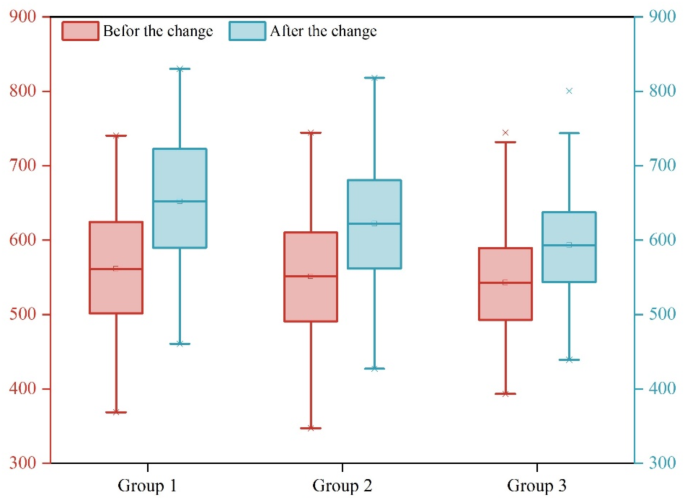
6MWT before and after two measurements (in m).
link






